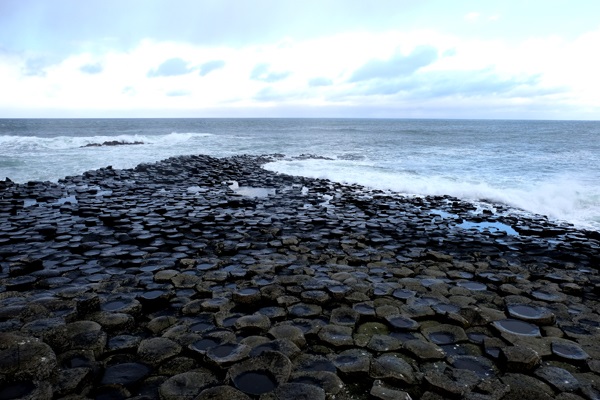
Last year for Christmas, Richard and I spent a month traveling (side note – am I the only one who always tries to spell this traveling?) around the UK. We spent time in England, Northern Ireland, and Wales, and even drove through Scotland (albeit without stopping) while visiting his family! For some reason, one of the things we remember most is getting stuck in the wind and rain outside of our hotel beside the Giant’s Causeway after a fire broke out. Not exactly the most fun we’ve had, but the reward was worth it!

We were in the middle of a wonderful breakfast at the hotel, when one of the dryers in the laundry caught fire, and we were told we had to go outside right away. Unfortunately, it was in the middle of December, and of course, we forgot to wear our winter coats to the dining room. After freezing outside for a while, we were brought into the nearby visitor center to wait until the firemen cleared the building. Luckily nothing was damaged.

As we were checking out after breakfast, they asked us if we had managed to finish our meal before the fire. With the exception of a cup of tea or two, we had, but we asked them if they could do us a favor in lieu of the rest of our meal. Would they be willing to share their wheat bread recipe with us? I doubted they would as restaurants/chefs aren’t normally known for that sort of thing, but lo and behold, the chef not only gave us the recipe, but a loaf of bread (still warm from the oven) to take with us!

Now, I should just clarify what wheaten bread is for those of you who aren’t familiar. In Northern Ireland, two of the favorite breads (at least where Richard is concerned) are soda bread and wheaten bread – both quick breads made without yeast. Wheaten bread (the proper kind) is a sweet bread, made with really coarse whole-grain flour, normally eaten with some butter or jam (or both!). They can sometimes be shaped in boules but normally baked in tins (it’s a super wet mixture), and they are a bit crumbly due to the flour and lack of gluten development. They remind me a bit of cornbread, in that they are sweetened both by sugar as well as the grain itself.

The wheaten bread at our hotel was the best Richard had ever had, which is why we wanted the recipe so much. Of course, it was written as a chef would, with no temperature, or instructions, and to make 12 loaves. I adjusted the recipe to make only 2, and have tried it a few times, trying to make it just like it was back in County Antrim. The key I have found is that you don’t work the batter too much (just mix until all the dry has been moistened) and use a really coarse whole grain flour (ideally fresh, as whole grain flours can go rancid or lose some flavor sitting around too long). At the end of the day, this whole wheat bread gets a lot of its sweetness from the grain itself, so it’s a pretty important part.

This recipe makes enough for two loaves of bread, in a regular loaf tin. I tend to store it well wrapped up in cling film to prevent it from drying out. It won’t last as long as a regular loaf of bread, but with the thick slices we tend to cut, that’s okay!.
Northern Irish Wheaten Bread
Ingredients
- 567 grams coarse wholemeal flour
- 180 grams all-purpose flour
- 142 grams caster sugar
- 2 tsp baking powder
- 1.5 tsp baking soda
- 0.5 tsp salt
- 76 grams margarine
- 3 eggs
- 568 grams buttermilk*
Instructions
- Preheat oven to 200°C (392°F). Grease two loaf tins and line with parchment paper.
- In a large bowl, mix together the flours, sugar, baking powder, baking soda, and salt. Rub in the margarine until it resembles breadcrumbs.
- In a separate bowl, whisk together the eggs and buttermilk. Make a well in the flour mixture, and pour in the liquid.
- Mix together just until all the flour is moistened, being careful not to overmix.
- Divide the batter between the two tins (about 820 g each) and lightly flatten the tops.
- Bake in the preheated oven for 30-35 minutes, until a toothpick comes out clean and the top is golden. You want to make sure the bread is fully baked, without becoming dry.
- Allow the loaves to cool in their tins for a few minutes before removing to a rack. Once they are only slightly warm to the touch, wrap them well in cling film to prevent drying out.
Notes
For every cup of buttermilk (250 ml) you use a ratio of 15 ml vinegar/lemon juice to 235 ml of milk.. Let it sit for at least 5 minutes before using.
If using this method entirely, use 34 ml acid and 534 ml milk for the recipe.